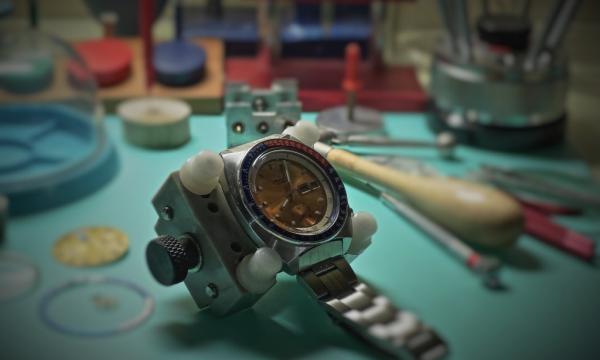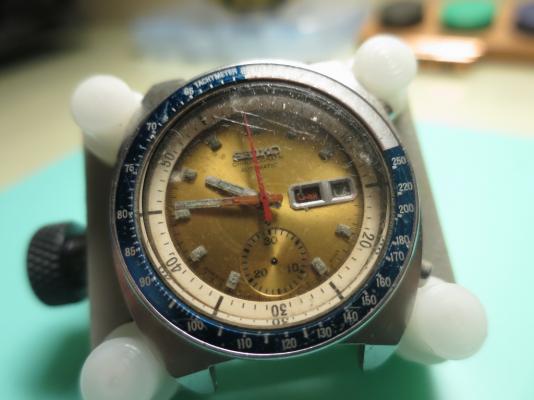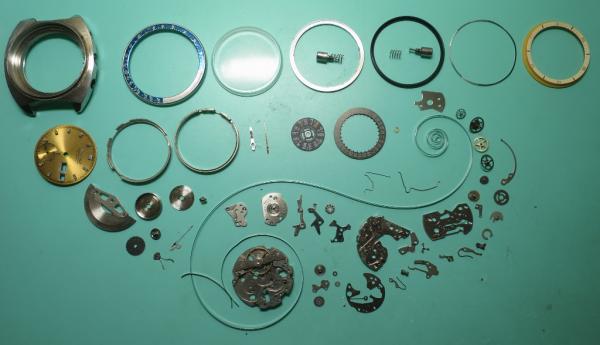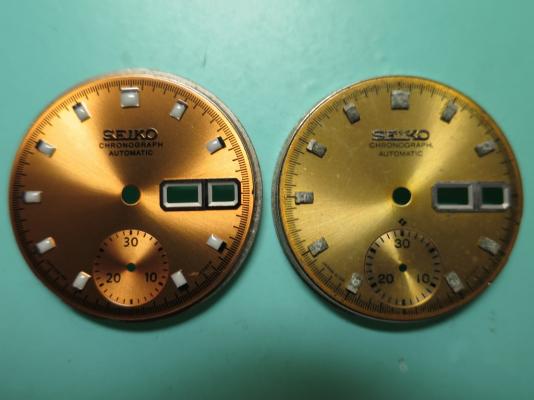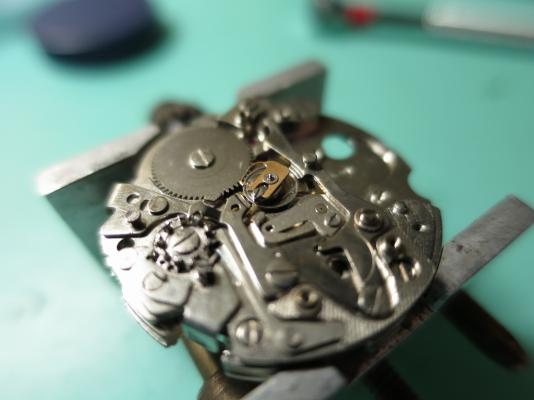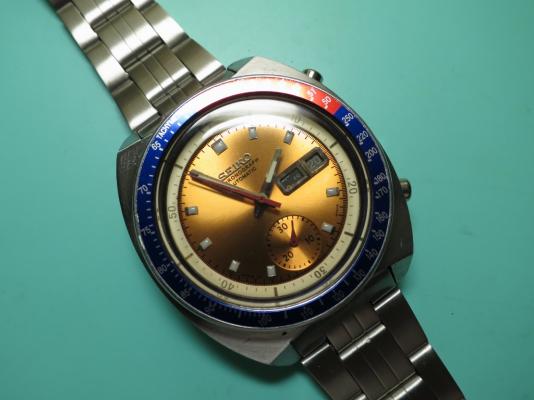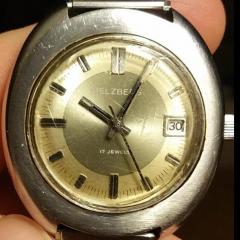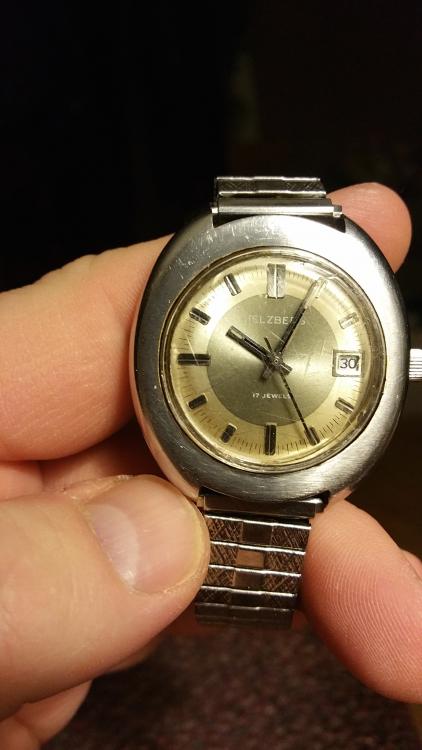Leaderboard
Popular Content
Showing content with the highest reputation on 01/04/17 in all areas
-
That's just typical today. In other words sod you we don't give free advice just give us your money. I'd write back and tell them where to shove the watch.2 points
-
When fitting new stems to watches I use these tools :- Digital calipers, Fine grade diamond lap Wire cutter Pin vice Now for fitting. (1) Hold the stem in the pin vice and screw on the crown tightly by hand. (2) With the movement fitted correctly in the case, insert the stem until it locks in place. Now measure the gap between the case and the underside of the stem. In this case it is 2.16mm. (3) Subtract 0.2mm from this size and this will give the amount to remove from the stem. In this case it will be 1.96mm which will give 0.2mm clearance below the crown when fitted to the watch. (4) Now remove the crown from the stem and hold the stem very tightly in the pin vice, then place the pin vice and stem between the jaws of the digital calipers then zero the calipers. (5) Remove the calipers and without touching the zero button set them to minus 1.96mm. THEN RE-ZERO THE CALIPERS AT THIS LENGTH The wire cutters are now used cut off the excess thread leaving a small amount to be filed to the exact length. (6) All that is required now is to dress the stem with the diamond lap a little at a time until the calipers read zero. (7) Finally screw the crown on tightly and it should be ready to fit to the watch without further adjustment. I find that this method cuts down on trial and error. FOR SCREW DOWN CROWNS. A) Screw down the crown tightly onto the case without the stem and measure the distance nbetween the bottom of the crown and the case. B ) Screw the new stem tightly into the crown, then insert into the watch until it engages and locks into the movement. C) Press the crown down firmly as far as it will go and hold it there. D) Using the vernier callipers, measure the distance between the bottom of the crown and the case. E) Subtract the size determined in (D) from the size measured in (A) then subtract a further 0.15mm from this size. This is the amount to shorten the stem by. This should allow the crown to screw full home without compressing the stem too tightly between the movement and the inside of the crown. F) Cut the stem leaving it slightly longer than the size determined in (E), and dress down to size using the diamond lap and vernier callipers as described in the original post. G) Screw the crown onto the shortened stem and check fit and function, before using a tiny spot of Loctite 221 to secure. Click here to view the article1 point
-
1 point
-
I've tried Googling it, but can't seem to find the right words. What dictates the frequency that a movement runs at. i.e. 18000 or 21600, and is there any way of knowing the speed, just by looking at the components?1 point
-
Hi, Does anyone know where I can get a JLC balance jewel(lower) replacement. It is 2mm OD and .34mm ID? Thanks in advance for your help,1 point
-
1 point
-
I wish to offer an apology for the irregularities of the previous entry. I could not edit the content. But I leave here the link to see my idea on how to improve the sound of a microphone for the application Wach-O-Scope http://reparacionderelojes.weebly.com/watch-o-scope-mic.html Guido.1 point
-
I always put the movement in the movement holder when i put it in the timegrapher? Never directly on the timing machine. And if i have it mounted in the case i make sure the crown is against the fixed mount? Seams to work better that way. Make sure that the hairspring don't touch the balance cook? it could be very tricky to set the height of the hairspring stud? And that the endcaps are right way up? Have you checked if it could magnetic. Had problem this week with a magnetic balance cook or hairspring on a Omega 610 . Every time i turned it dial down it suck the hairspring to the balance cook? Making it run very strange.1 point
-
Oh and that micro adjuster should be in the middle I must of caught it when opening the back but it's been one those weeks Anyway. Hopefully it shows without the correct tech info regards lift angle you will do just as well studying the swing of the balance regards amplitude than info given by a timegrapher Sent from my SM-G920F using Tapatalk1 point
-
The seller is elisabeth9679. Ships from France but only has taken about a week generally to arrive.1 point
-
There is a seller on ebay who sells smaller volumes of moebius so it is more affordable if your just doing it as a hobby. She sells like 1ml and 2ml portions1 point
-
It was important for military chronometer-grade watches. Y'know, "Gentlemen, synchronise your watches", etc. In the early days of WW2, the Weems watch was used for navigation. This was non-hacking and used a simple bezel like you see on divers watches to set the "zero seconds" point. Later, the MoD specified watches to be hacking, such as the IWC Mk11, so they could simply be set to the exact time by halting the movement while adjusting.1 point
-
There are purists who advocate don,t touch as this devalues some vintage watches. I did see a few years ago a article showing a specialist who restores clock & watch dials and he was hand painting them. A very skilful guy who and incredibly steady hands. There are watch dial restore companies to be found in the resources section of this site.1 point
-
Just changing hands should not cause the canon pinion to slacken if it was in good condition in the first place. If the canon pinion is slack on the calibre you mention, it will have to be replaced due to the type it is. Friction is not governed by the internal diameter of the tube, it is factory set where the large wheel is attached to pinion. Is there a possibility you have inadvertently enlarged the hole in the hand when fitting it?1 point
-
Allows you to synchronize the watch seconds. Say in reality the time is 2:05:35 without hack you could set it to 2:05 easily, but if the watch is running, trying to get the seconds running on 35 is impossible.1 point
-
Oh yeah...this is par for the course, but I don't play golf. I'd write them like oldhippy suggests. J1 point
-
Thought it was time to share some pictures of my new lathe now it's all cleaned up. Sorry, no pictures of it in pieces, but my hands weren't in a fit state to touch my phone or camera. It was extremely grubby and the rear bearing was very tight on the spindle and took some removing and a bit of polishing to make it fit properly, but apart from that all was very straight forward and it seems to run very true and smoothly when adjusted. The cross slide has lost most of its plating, but the slide rails are adjustable to take out any wear. I patiently rewired the 50 to 60 year old motor controller (sewing machine type), only for a big capacitor in it to go bang after 5 minutes, so I decided a new motor and controller would be a better bet. That's still in the post, and I'll wait for it before mounting on a board. I would like at some point to find a tailstock drilling attachment - one popped up on ebay today, but it's expensive as it has a whole tailstock with it that I don't need and may not be able to shift on again. I also need to get the female end of the tailstock runner re cut as it's quite badly chipped. I followed the instructions inside the lid and have boight some Mobil velocite #6 for the bearings. The cross slide has a thin smear of grease for now, so will see how that goes.1 point
-
Confused yep. From Walthams the movement leaving the factory in new condition after quality inspection, would, as I was told by an enthusiast, be expected as regards the arc of the balance wheel arm be expected to reach 270 degrees. This was in the says of electronics or even airplanes! Fine tuning of beat was after adjustments made, done by the regulators ear! Listening to the movement. It's very unfair to compare normal present day watches to old vintage pieces of 100 years old or so. Regards amplitude and timegrapher on these old pocket watch movements, it's more appropriate to set the lift angle to 40° than the preset 52° Which will I believe bring the amplitude down to a more accurate figure, if indeed, amplitude even concerns you on these lovely old movement's. As for assessments made with a timegrapher on low amplitude movement's. The timegrapher still has its uses and I'm referring more to studying the dotted lines as the movement is placed in different positions. Though anything readings assessed with an amplitude of less than 180 should be taken with a pinch of salt. Personally I'm more than happy with my old pocket watches if they still tick after being wound. If the OPs balance wheel arm is rotating to 270 degrees . To me he almost certainly has a great watch in great condition. The above is my humble opinion and as the saying goes " Opinions are like **BLEEP**holes, everybody has one." Sent from my SM-G920F using Tapatalk1 point
-
It's one of the unfortunate problems of collecting electric watches they're going to disintegrate unfortunately. The plastics used in some electronic watches were not meant to last forever. Little while back I was servicing a quartz watch that the main plate was reinforced with a lot of plastic. Basically the main plate was in the plastic. The plastic was starting to disintegrate I could see all sorts of cracks and fractures in the plastic the most part it was not a problem except around the battery that needed to be glued back together again.1 point
-
So looking at what you've written thinking no no no then feeling really really really stupid. This of course is why I got a timing machine at least one of the reasons. Timing machines also helps you diagnose things that can't be seen on the graphical display there really a must have and now affordable very affordable thanks to the Chinese. So you look at my image were seeing the balance swing from one extreme to the other and amplitude is one half of that. So the video was still helpful without a timing machine we see that the complete oscillation is roughly 270 and you're running one half 135 that which is very very bad. So what is a good amplitude? Before we get the numbers as amplitude decreases everything bad in the watch gets magnified. So as you go falling in amplitude positional errors increase the effect of the escapement in a bad way increases Or simplistically timing flies out the window. Then for numbers we have issues in that whose numbers you want to look at? Some watch companies will tell you when the watches fully serviced it should have amplitude between certain degrees but a modern Rolex for instance is going to time differently than antique American pocket watch. Then companies like Omega publish the minimum amplitude at the end of 24 hours. Then some timing machine companies in their documentations will have recommendations but it all depends on the watch. Rolex watches will typically go at least 48 hours so at 24 hours that's only 50% of the power reserve you going to get a different amplitude than we are with a pocket watch. Omega while listing minimums for most their various watches also has a chart for their antique watches. They listed by size and they never made or at least are not acknowledging of making a pocket watch this size. So the minimum they have is 180° unless it's a tiny ladies watch that can go 160°. Rolex 200° minimum for all their watches with a maximum for two of them at 280 otherwise 300°. Then Witschi has a couple PDFs on timing mechanical watches found below and they have recommendations. I've attached an image out of the first PDF below. Then as a reminder timing in one position dial up or dial down isn't always the best as usually gives you the best amplitude. So it always helps to put in at least one pendant position. http://www.witschi.com/assets/files/sheets/Witschi Training Course.pdf http://www.witschi.com/assets/files/sheets/Test and measuring technology mechanical watches.pdf1 point
-
when installing these springs ... check to see if it is totally flat, a spring with a slight twist will tend to fly off. parts tray.You will notice this if the spring is lying flat in your For springs made from flat stock, also check if the ends are not 'twisted'.. not so easy to spot ... best bet is to view it from directly above. This applies to all springs. Anil1 point
-
Santa came through this year with my first real tools. I replaced the movement in my dad's watch, the one I broke when I was about 5 by winding it all of the time. I found a used movement, the exact same one that was in it to begin with. It cost me $15 including shipping all the way from England. It started ticking again on Christmas Day for the first time in 38 years. I wish dad was still around. He would be tickled pink. He loved this watch. Nothing fancy to most, but it was to him. I've been wearing it for 5 days now. It keeps perfect time, and it turns out I still like to wind watches. I'll be more careful now though.1 point
-
The instruction manual offers no direct method of changing the battery despite being in several languages.. There is the part that implicates am involved method of getting to the inside: For servicing and repairs, the removal of the access screw on the back of the watch gives access to the stem release-catch; after removal of the crown and stem, pressured air is inserted to blow-out the crystal. Thereafter, the entire movement, together with the dial and hands are easily removed from the top. Experienced watchmakers with the necessary equipment should only perform this operation and the removal of the access-screw by any other persons without the required expertise is highly discouraged. Unfortunately, this is the way to change the battery. If you look up how to un-case an Omega Seamaster Cosmic 2000, you may find some people mention using pressurized air to pop the crystal out and remove the movement to replace the crystal. I must add that I do not have experience with this particular Braun watch, but if its a ronda chrono quartz, it must have a battery; and changing that battery is of course part of the servicing mentioned in the instruction manual. Its gonna be tricky, but hopefully you'll hear from some others on this site---by the way WELCOME!! J1 point
-
Hi Mtsaz, I hope that the above is of some help, it is a 2783 but should be the same as the 2784. It should be possible to install the jumper and the spring as above but you have to ensure that the opposite date ring retaining plate is secure first so that the date ring doesn't move about too much. I install the jumper first and then the spring. With the spring I first of all get the leg that goes against the jumper in place, and then using a piece of peg wood on top of the "U" bend in the spring to hold it all in place I push the other leg into position with tweezers. I then very carefully place the retaining plate on top and secure it with the screw. This is an operation that is prone to the spring making a bid for freedom and often takes 2 or 3 attempts. The peg wood helps to control things, I have also heard of people using rodico over the spring to reduce its range if it goes. Another trick is to perform this operation inside a clear poly bag which can drastically reduce the search time. I am however intrigued by Rogart's suggestion of installing the spring through the hole. I will have to try that because if it works then it has to be the way to go, and it would explain why the hole is there. Good luck :-)1 point
-
Very interesting article & yes maybe it is the future of lubricants. My only issue is not the non friction properties of the crystalline oils but can they stay where put. This is the dilemma with watches & clocks. They need lubrication but the oil/greases must stay where applied.1 point






